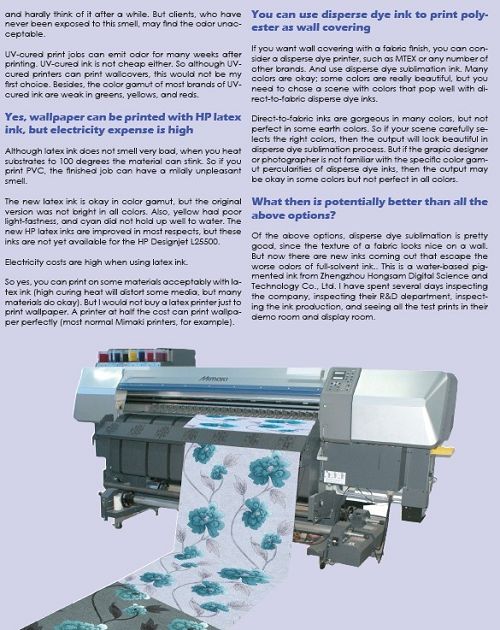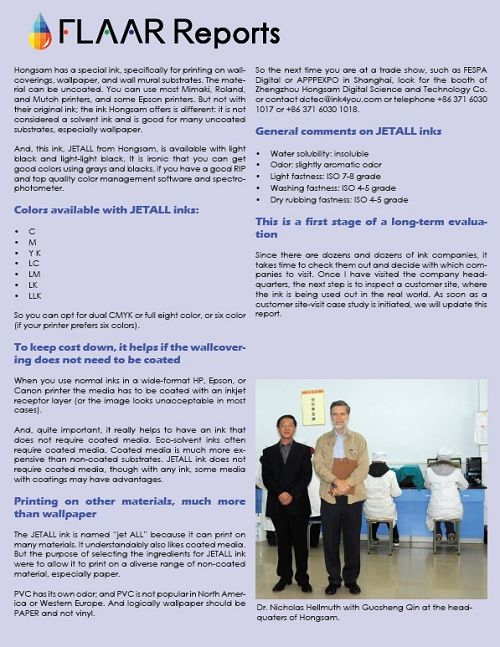 Jun 22,2021
Jun 22,2021
At the beginning of 2011, Dr. Nicholas Hellmuth, director of FLAAR Reports, senior editor, and inkjet expert, visited Hongsam Digital Industrial Park and highly praised Hongsam Digital's corporate philosophy of "Science, Integrity, Transcendence, Environmental Protection". Dr.Nicholas Hellmuth wrote the article“HONGSAM Wallpaper JETALL® Water-based Pigmented Ink”scientifically and rigorously after in-depth investigation, and posted it on FLAAR Reports in the same year.
The following is the original article:




HONGSAM Wallpaper JETALL Water-Based Pigmented Ink
Article contents
PRINT DIRECTLY Wallpaper JETALL Water-Based Pigmented Ink
With NO solvent odor, solvent HAPs, solvent out-gassing
Also Prints on Uncoated Paper
No more requirement to limit printing of wallpaper to fex ographic printing technolagy. Don't need rotary screen or rotogravure at all. Today you can print wallpaper with wide-format inkjet printers.
And, you can do your own customized designs. If you wish, you can print your own wallpaper yourself.
And today, when people and corporations do not want harmful chemicals in their residence or workplace, there is no excuse to continue using solvent inks, or vinyl either.
Yet it is notable that almost all of the offerings for wallpaper on the Internet are with solvent or UV-cured inks. We discuss the downsides below.
FLAAR is interested in all aspects of interior decoration
Our background at FLAAR is in architecture. I studied architecture at Harvard and have spent decades researching and writing about architectural history (Mayan pyramid-temples, palaces and sacred ballgame courts). For the present decade we have dedicated our resources tod learning about wide-format inkjet printing on wood, stone, ceramic tiles, and glass. This same decade I have also been doing research on innovative inks to print on atypical material (material other than for traditional advertising signage). Wallpaper, wallcoverings, and wall murals are all part of our interest.
We are especially interested in wall coverings for museum Digitally printed wallpaper is especially pertinent for temporary museum exhibits.exhibits, both temporary exhibits and permanent exhibits.
So anything and everything about interior decoration is what we enjoy learning about, and once we have year(s) of research and experience, then we issue FLAAR Reports to assist individuals and companies to learn how to do customized wallcoverings. And one thing is helpful at the beginning: to understand which inks, substrates, and printers are not ideal. It is as crucial to learn what is not appropriat for reproducing wallpaper as it is to understand what options are optimal.
So to begin our journey into printing customized images onto wallcoverings, let's frst learn which printers and inks are not ideal.
Wallpaper is best printed without solvent odor
If you print wallpaper with solvent ink, it will stink for days, possibly weeks.
No restaurant, no home, and no offce would put up with the smell of wallpaper freshly printed with solvent ink. Even eco-solvent ink has an unpleasant odor.
If the wallpaper material is PVC, the odor of the PVC will also mix with the smell of the solvents.
Wallpaper may be better not printed with UV-cured ink
The most popular-selling printers today, and for the last six years, are UV-cured printers. Since printshops have invested heavily in UV-cured printers it is understandable they wil want to use UV-cured machines to print on wallpaper.
But there is no particular need to use a quarter-million dol lar UV-cured printer to produce wallpaper. This is overkill. And most big production roll to roll UV-cured printers have 50 picoliter drop size, or 30 picoliters. Print quality is not ad equate.
Plus, UV-cured ink can have an awful smell. Some brands of UV-cured ink are much much worse than others. And some settings (some print modes) result in more smell than other print modes. Indeed it would be a challenge to decide which can have the most offensive odor: solvent ink. or UV-cured ink. Print shop personnel get used to the odorand hardly think of it after a while. But clients, who have never been exposed to this smell,may fnd the odor unacceptable.
UV-cured print jobs can emit odor for many weeks after printing, UV-cured ink is not cheap either. So although UVcured printers can print wallcovers, this would not be my frst choice. Besides, the color gamut of most brands of UV. cured ink are weak in greens, yellows, and reds.
Yes, wallpaper can be printed with HP latex ink, but electricity expense is high
Although latex ink does not smell very bad, when you heat substrates to 100 degrees the material can stink. So if you print PVC, the fnished job can have a mildly unpleasant smell.
The new latex ink is okay in color gamut, but the origind version was not bright in all colors. Also, yellow had poor light-fastness, and cyan did not hold up well to water. The new HP latex inks are improved in most respects, but these inks are not yet available for the HP Designjet L25500.
Electricity costs are high when using latex ink.
So yes, you can print on some materials acceptably with le tex ink (high curing heat will distort some media, but many materials do okay). But I would not buy a latex printer just toprint wallpaper. A printer at half the cost can print wallpaper perfectly (most normal Mimaki printers, for example).
You can use disperse dye ink to print polyester as wall covering
If you want wall covering with a fabric fnish, you can consider a disperse dye printer, such as MTEX or any number of other brands. And use disperse dye sublimation ink. Many colors are okay; some colors are really beautiful, but you need to chose a scene with colors that pop well with direct-to-fabric disperse dye inks.
Direct-to-fabric inks are aorgeous in many colors, but not perfect in some earth colors. So if your scene carefully se lects the right colors, then the output will look beautiful in disperse dye sublimation process. But if the grapic designer or photographer is not familiar with the specifc color gamut percularities of disperse dye inks, then the output may be okay in some colors but not perfect in all colors.
What then is potentially better than all the above options?
Of the above options, disperse dye sublimation is pretty good, since the texture of a fabric looks nice on a wall. But now there are new inks coming out that escape the worse odors of full-solvent ink. This is a water-based pigmented ink from Zhengzhou Hongsam Digital Science and Technology Co., Ltd. I have spent several days inspecting the company, inspecting their R&D department, inspecting the ink production, and seeing all the test prints in thein demo room and display room.
Honasam has a special ink. specifcally for printina on wall coverings, wallpaper, and wall mural substrates. The material can be uncoated. You can use most Mimaki, Roland, and Mutoh printers, and some Epson printers. But not with. their original ink; the ink Hongsam offers is different: it is not considered a solvent ink and is good for many uncoated substrates, especially wallpaper.
And, this ink, JETALL from Hongsam, is available with light black and light-light black. It is ironic that you can get good colors using grays and blacks, if you have a good RIF and top quality color management software and spectrophotometer.
Colors available with JETALL inks:
C
M
YK
LC
LM
LK
LLK
you can opt for dual CMYK or full eight color, or six color (if your printer prefers six colors).
To keep cost down, it helps if the wallcover ing does not need to be coated
When you use normal inks in a wide-format HP, Epson, or Canon printer the media has to be coated with an inkiet receptor layer (or the image looks unacceptable in mos cases).
And, quite important, it really helps to have an ink that does not require coated media. Eco-solvent inks often require coated media. Coated media is much more expensive than non-coated substrates. JETALL ink does not require coated media, though with any ink, some media with coatings may have advantages.
Printing on other materials, much more than wallpaper
The JETALL ink is named "jet ALL" because it can print on many materials. It understandably also likes coated media. But the purpose of selecting the ingredients for JETALL ink were to allow it to print on a diverse range of non-coated material, especially paper.
PVC has its own odor; and PVC is not popular in North Amer ica or Western Europe. And logically wallpaper should be PAPER and not vinyl.
So the next time you are at a trade show, such as FESPA Digital or APPPEXPO in Shanghai, look for the booth of Zhengzhou Hongsam Digital Science and Technology Co. or contact dctec@ink4you.com or WhatsApp: +86 19036977269.
General comments on JETALL inks
Water solubility: insoluble
Odor: slightly aromatic odor
Light fastness: ISO 7-8
grade Washing fastness: ISO 4-5 grade
Dry rubbing fastness: ISO 4-5 grade
This is a first stage of a long-term evaluation
Since there are dozens and dozens of ink companies, it takes time to check them out and decide with which com panies to vist. Once I have visited the company headquarters, the next step is to inspect a customer site, where the ink is being used out in the real world. As soon as a customer site-visit case study is initiated, we will update this report.